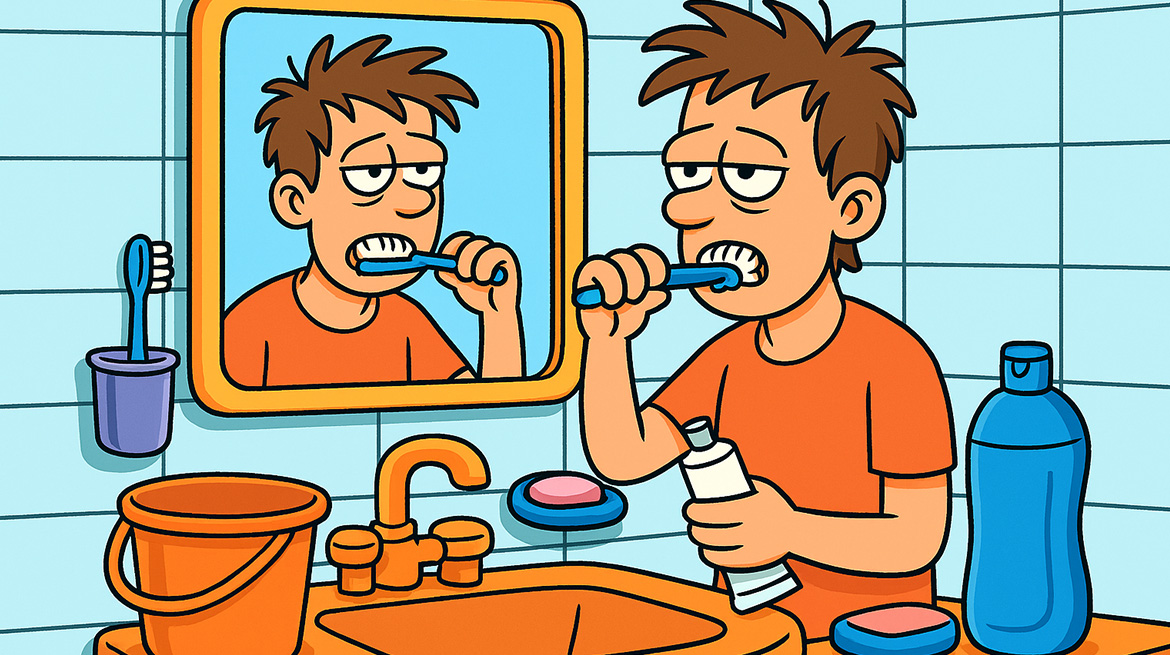This morning, I stood in front of the mirror half asleep, my hair a wild mess. That’s when it hit me. Not some deep thought about life or dreams. Just something oddly… synthetic.
My entire bathroom was practically made of plastic!!
I held a plastic toothbrush in one hand, toothpaste in a plastic tube in the other, a plastic brush holder right above the sink, a plastic bucket, a plastic mug, a plastic soap case, a plastic shampoo bottle, and even the tap knobs and pipes. I saw plastic, plastic , plastic all around me. That’s when I realized, I was living in a world of plastic, built for convenience. If my ancestors from a hundred years ago saw my bathroom, they would probably think they have walked into a scene from a cheap sci-fi movie with even the mirror frame made of plastic.
And guess what? Today is June 5th, 2025 World Environment Day. This year’s theme is “#BeatPlasticPollution.”
Sounds noble, right? But then I look at my bathroom again, and… well, I’m practically showering in hypocrisy.
A Brief Love Story (and Breakup?) with Plastic
We didn’t always live like this. Plastic has a relatively short but impactful life story. It all began in the mid-1800s when curious chemists started modifying natural materials like rubber and shellac to create semi-synthetics like Parkesine and celluloid.[1] Then came the big break in 1907 with Bakelite, the first fully synthetic plastic, leading to an era where anything seemed possible and mouldable.[2,3]
Fast forward through the World Wars; necessity, as always, became the mother of invention. We got nylon, PVC, and later, superstar materials like polyethylene and PET that made plastic bottles, bags, buckets, and Barbie dolls.
By the time the 1970s rolled around, plastic was everywhere. A miracle of modernity: cheap, durable, and lightweight. But it came with an expiry date we forgot to read; the environment couldn’t digest it.
Mirror, Mirror on the Wall, Who’s the Most Polluted of Them All?
I stood there, brushing my teeth a little more thoughtfully than usual. It’s funny that plastic has made life so easy, yet the very ease of it has created an environmental monster. Globally, we produce an approximate of 400 million tonnes of plastic a year, and nearly half of that is single-use.
We sip from plastic straws for ten minutes; they linger in the oceans for centuries.
We buy fruits wrapped in plastic, forgetting nature already gave them biodegradable skins.
We wear plastic (polyester = plastic clothes), sit on plastic, eat from plastic, and sometimes, even eat plastic in the form of microplastics that have entered our water and food.
Can We Imagine a World Without Plastic?
Here’s the real head-scratcher: can we live without plastic?
Honestly? Not completely. At least not right now. Plastic is still super important in things like medicine, electronics, transport, and hygiene.
But what we can do is live without the unnecessary stuff that is the single-use plastics, the extra packaging, and all the plastic junk we throw away without a second thought.
So, what now? Back to Bamboo and Banana Leaves?
Well… maybe a little bit, yes.
- Switch to bamboo toothbrushes (they actually look pretty cool).
- Try bar soaps instead of liquid ones in plastic bottles.
- Bring your own cloth bags, steel water bottles, and reusable coffee mugs.
- Say no to unnecessary packaging. Your avocado doesn’t need to be mummified in plastic.
And more importantly, talk about it. Teach kids that straws aren’t magic wands and that they leave a mess behind. Join community clean-ups. Support policies that hold corporations accountable. And choose products that actually care about the planet.
Final Thought from the Mirror
As I rinsed my mouth and reached for the plastic mug (note to self: really need to swap this one), I caught a glimpse of myself in the mirror and smiled. Maybe it’s not about escaping the plastic-filled world altogether but about reshaping it. One small step at a time. One mug, one habit, one conscious choice at a time.
On this World Environment Day, let’s remember: we’re not aiming for perfection; we are aiming for intention.
Let’s live lighter. Let’s live better. And maybe, just maybe, one day, our grandchildren will stand in front of their mirrors and wonder what all the plastic fuss was about.
As for me, the morning revelation didn’t turn me into a plastic-free guru overnight. But I did order a bamboo toothbrush, swapped the bucket for a steel one, and began hiding my plastic shampoo bottle in shame. It’s a start.
We built this plastic sanctuary, layer by layer. The question is: can we now strip it down one choice at a time?
And while I still haven’t figured out how to replace my plastic tap without flooding the bathroom, at least I know that real change begins with one very confused, very reflective stare in the mirror.
References
- Science History Institute. The history of plastics [Internet]. Philadelphia: Science History Institute. Available from: https://www.sciencehistory.org/topics/plastics
- Andrady AL, Neal MA. Applications and societal benefits of plastics. Philos Trans R Soc Lond B Biol Sci. 2009 Jul 27;364(1526):1977–84. doi:10.1098/rstb.2008.0304
- Geyer R, Jambeck JR, Law KL. Production, use, and fate of all plastics ever made. Sci Adv. 2017 Jul;3(7):e1700782. doi:10.1126/sciadv.1700782




